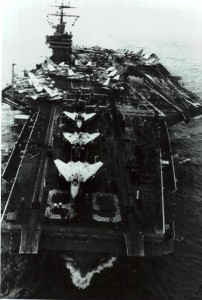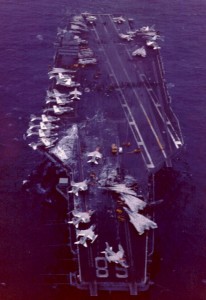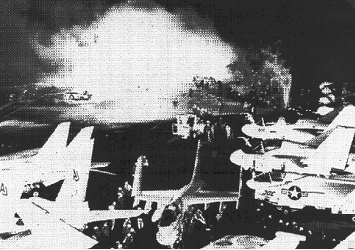On 26 May 1981 there was another munition accident on the flight deck of an aircraft carrier. As USS NIMITZ, CVN-68, was operating at night off the coast of northern Florida. An EA-6B aircraft attempting to land drifted to the right of the flight deck centerline and struck the tail of an SH-3 helicopter. It then hit three parked A-7E aircraft, a tow tractor and three F-14 aircraft before coming to rest on the port edge of the flight deck. An intense fuel fire erupted.
USS NIMITZ (CVN 68) 26 May 1981. Fire on the flight deck following the crash of an EA-6B aircraft. U.S. Navy photo
The three F-14 aircraft involved in the fire were each configured with one AIM-7F SPARROW missile, one AIM-9L SIDEWINDER missile, one AIM-54 PHOENIX missile, and a quantity of 20mm target practice ammunition.
The fire was fed by a continuous flow of JP-5 fuel from the punctured tank of an F-14 aircraft that had just been refueled. The flight deck fire fighting systems prevented the fire from spreading and the fire was contained in an area of about 4000 square feet. Throughout the fire, numerous hoses were trained on the missiles to keep them cool. About 28 minutes after the fire began, it was believed “out” and the order was given to move into the area to start on the clean up.
As the sailors approached the scene, a SPARROW missile warhead detonated. This was an unexpected slow cook-off reaction of the explosive in the warhead. The SPARROW missile had detached from the launcher of an F-14 aircraft during the fire and was among the hot debris on the deck. The warhead explosion killed two crewmembers, injured seven and rekindled the fire. The warhead detonation made a 12-inch long by 24-inch wide by 3-inch deep depression in the flight deck.49 Two more SPARROW warheads and one SIDEWINDER warhead detonated after the first explosion. In all, fourteen sailors were killed and thirty-nine were injured in this accident. Also, three aircraft were destroyed and nine were damaged. The cost to repair the material damage from this accident was over 58 million dollars.

|

|
USS NIMITZ (CVN-68) Returning to port after the fire and munition explosions. U.S. Navy photos.
The USS NIMITZ incident increased the concern about the cook-off sensitivity of munitions and ship survivability. VAdm. Bulkeley asked for a follow-up briefing on the progress in the EAD program. I briefed him and the Board of Inspection and Survey on 26 February 1982. He suggested that the Fleet Commanders should be apprised of our efforts to make insensitive ordnance. The OP-354 staff was asked to make the arrangements. On 22 April 1982 Mr. Max Stosz of White Oak and I presented the pre-brief of what we expected to present to the Fleet Commanders to VAdm. Walters, OP 03, for his approval. We followed with a briefing to VAdm. Johnson, the COMNAVSURLANT, in Norfolk, VA on 4 May 1982.
49“Navy Studies EA-6B Crash on Nimitz”, Aviation Week & Space Technology, P. 115, September 13, 1982.
